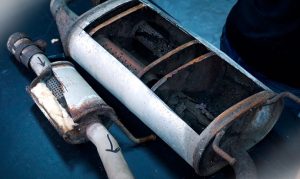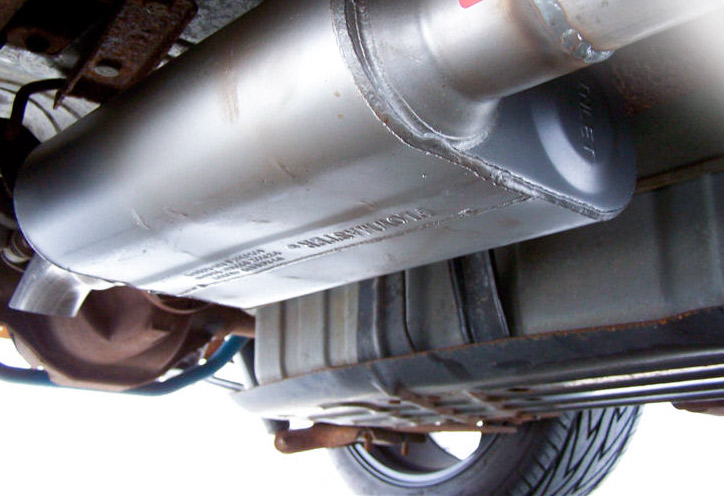Ford vehicles have one thing in common: they come packed with mighty engines and boast an impressive power output. They rarely break down and can overcome pretty much any challenge. As for the exhaust systems, they’re rather decent. However, while the exhaust manifold, tailpipes, and catalytic converter are, indeed, pretty solid, the same can’t be said about the muffler.
This gear has one job: to keep exhaust noise to a minimum. But, it’s not always up to the task. This is especially true if you’ve got customized pipes or a brand-new header. So, what can you do to fix that? Great news: there are some tried and true solutions. Today, we’ll talk about the importance of finding the right location, soundproofing the muffler, the pros of silencers, loudness wars, and more. Stay tuned!
How Do Mufflers Work? Are They Effective?

Besides, you might get sued for that (we’ll talk more about this later). On top of that, when the system fails at controlling the fumes and the sound waves, it can lead to a drop in powertrain efficiency. And how do mufflers battle this, exactly? The answer is destructive interference. The louder the sound waves, the higher their pressure.
A muffler “cancels” out the loud sounds by introducing a series of minimum-pressure sound waves. This is achieved through tubes and perforators inside of the muffler. They direct the sound into the resonator, which, in turn, traps the fumes and dampens the noise. So, yes, mufflers are, indeed, pretty useful and do a fairly decent job of making your Ford quieter.
Muffle Location: Does it Matter?
Ok, we just learned how mufflers work and what makes them effective. Now let’s answer one more important question: Does muffler location matter? Some experts recommend placing the muffler towards the front of the vehicle (where the manifold is). Others claim the rear axle is the best location for it. The middle of the exhaust system is a safe place to start. To find a better spot, you’ll have to experiment. Read here about Exhaust System for GMC Sierra.
What we’re looking for is a balanced, controlled tone with some “bite”. On newer trucks/SUVs, putting the muffler closer to the tailpipes usually works. The reason – the cooler the pipes, the easier it will be to tame the fumes without any performance drops. A good rule of thumb is to put the muffler 18-20” away from the header. This will give you a rumbly, deep, satisfying growl. And I don’t see much reason in moving the muffler closer to the engine.
How Loud is Too Loud?
There’s nothing more frustrating than a Ford truck/SUV that rattles like a tractor from the 50s. If you live in the countryside, this might not be a very big problem. In contrast, a vehicle with a noisy exhaust system on a busy highway or a quiet neighborhood is a disaster. You’ll probably get more than one complaint unless you quiet down the Ford. Now, there are strict laws when it comes to how loud a car is allowed to get.
So, what is the legal DB for exhaust? In the United States, the limit is 95 DB. If you go over that mark, your neighbors will have a right to sue you. Ultimately, it’s up to police officers to determine whether the exhaust noise is over that threshold, or not. This is important: most stock exhaust systems rarely go over 75 decibels. However, if the muffler is failing/not very effective, or you’ve got an aftermarket exhaust, the noise might just reach 100 DB.
More Ways to Dampen the Exhaust System
Alright, with the basics out of the way, let’s see what else the average Ford driver can do to keep the exhaust noises at bay. First of all, you can try and soundproof the muffler. Or, just buy a silencer and use it as an extra “layer of defense”. Last, but not least, check for leaks.
#1: Isolate the Muffler
Soundproofing isn’t very expensive and takes little time and effort. The most important thing here is to find the right material. Otherwise, it won’t introduce any real changes. And don’t go cheap: buy a dampening product that’s right in the middle of the price range. Spray foam, fiberglass, vinyl sound barriers, and absorbing panels are some of the best options.
Make sure the material is heat-resistant, though. If you’re on a tight budget, a regular blanket will also do. Some experts recommend disassembling the muffler, putting some wood inside of it, and putting it back together. This is a risky method, however, and you’ll probably end up ruining the gear unless you’ve got the right skills and tools.
#2: Use a Silencer + Resonator
Even if you’ve got the Best Muffler for Ford, it might still not be enough to efficiently dampen the exhaust noises. That’s where silencers and resonators come in. Now, while a muffler mostly sits in the middle or the rear end of the exhaust chain, a silencer should always be attached to the tip of the tailpipe. It’s rather cheap and very easy to install. There are lots of DIY silencer tutorials out there.
You could use a soda can, or, say, jar lid as an improvised silencer. But, it would be wiser to just go ahead and buy an aftermarket unit from a local store. Resonators, in turn, are more complex and also serve as a link in the chain. In contrast to mufflers that reduce the volume, resonators change the tone of the sound.
#3: Look for Potential Leaks
Cracks and leaks make lots of noise. Besides, when left unattended for long, this leads to complete failure of the exhaust pipes. So, make a habit of inspecting the muffler and the resonator. Or, better yet, diagnose the entire exhaust system while you’re at it. If the leak isn’t too big, it can be fixed with adhesive tape, clamps, or a sealant. These products won’t cost you much and take 15-30 minutes to apply.



Add Comment